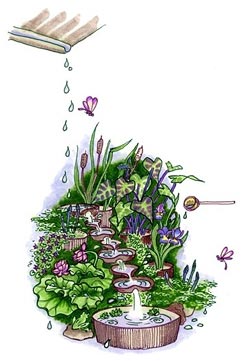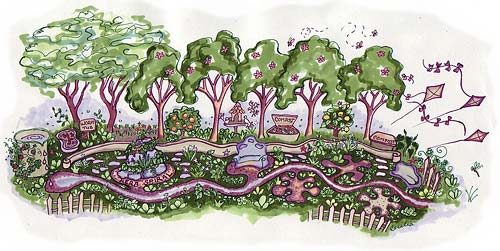Food Forests, Fungi, Land, Rehabilitation, Salination, Soil Biology, Swales, Trees — by Craig Mackintosh
This is just one example of how permaculture can transform the environment, and, in so doing, dramatically change lives. By evidencing the dramatic transformation possible in the world’s worst agricultural scenarios, we hope to make people stand up and listen
Big Agribusiness would convince us that continuing with fossil fuel dependent monocrop systems and genetically modified crops is the way of the future, but with fuel, transport and fertiliser costs skyrocketing, and growing evidence that genetic tinkering is causing far more harm than good, we, instead, advocate tried and tested methods of working with nature for the benefit of man.
Below is a behind the scenes look at Greening the Desert.
 Illustration by Cecilia Macaulay |
Permaculture (permanent agriculture) is the conscious design and maintenance of agriculturally productive ecosystems which have the diversity, stability, and resilience of natural ecosystems. It is the harmonious integration of landscape and people providing their food, energy, shelter, and other material and non-material needs in a sustainable way. Without permanent agriculture there is no possibility of a stable social order.
Permaculture design is a system of assembling conceptual, material, and strategic components in a pattern which functions to benefit life in all its forms.
The philosophy behind permaculture is one of working with, rather than against, nature; of protracted and thoughtful observation rather than protracted and thoughtless action; of looking at systems in all their functions, rather than asking only one yield of them; and allowing systems to demonstrate their own evolutions.
Permaculture in Landscape and Society
As the basis of permaculture is beneficial design, it can be added to all other ethical training and skills, and has the potential of taking a place in all human endeavors. In the broad landscape, however, permaculture concentrates on already-settled areas and agricultural lands. Almost all of these need drastic rehabilitation and re-thinking. One certain result of using our skills to integrate food supply and settlement, to catch water from our roof areas, and to place nearby a zone of fuel forest which receives wastes and supplies energy, will be to free most of the area of the globe for the rehabilitation of natural systems. These need never be looked upon as “of use to people”, except in the very broad sense of global health.
The real difference between a cultivated (designed) ecosystem, and a natural system is that the great majority of species (and biomass) in the cultivated ecology is intended for the use of humans or their livestock. We are only a small part of the total primeval or natural species assembly, and only a small part of its yields are directly available to us. But in our own gardens, almost every plant is selected to provide or support some direct yield for people. Household design relates principally to the needs of people; it is thus human-centered (anthropocentric).
This is a valid aim for settlement design, but we also need a nature-centered ethic for wilderness conservation. We cannot, however, do much for nature if we do not govern our greed, and if we do not supply our needs from our existing settlements. If we can achieve this aim, we can withdraw from much of the agricultural landscape, and allow natural systems to flourish.
 Illustration by Cecilia Macaulay |
Recycling of nutrients and energy in nature is a function of many species. In our gardens, it is our own responsibility to return wastes (via compost or mulch) to the soil and plants. We actively create soil in our gardens, whereas in nature many other species carry out that function. Around our homes we can catch water for garden use, but we rely on natural forested landscapes to provide the condenser leaves and clouds to keep rivers running with clean water, to maintain the global atmosphere, and to lock up our gaseous pollutants. Thus, even anthropocentric people would be well-advised to pay close attention to, and to assist in, conservation of existing forests and to assist in, the conservation of all existing species and allow them a place to live.
We have abused the land and laid waste to systems we never need have disturbed had we attended to our home gardens and settlements. If we need to state a set of ethics on natural systems, then let it be thus:
- Implacable and uncompromising opposition to further disturbance of any remaining natural forests, where most species are still in balance;
- Vigorous rehabilitation of degraded and damaged natural systems to stable states;
- Establishment of plant systems for our own use on the least amount of land we can use for our existence; and
- Establishment of plant and animal refuges for rare or threatened species.
Permaculture as a design system deals primarily with the third statement above, but all people who act responsibly in fact subscribe to the first and second statements. We believe should use all the species we need or can find to use in our own settlement designs, providing they are not locally rampant and invasive.